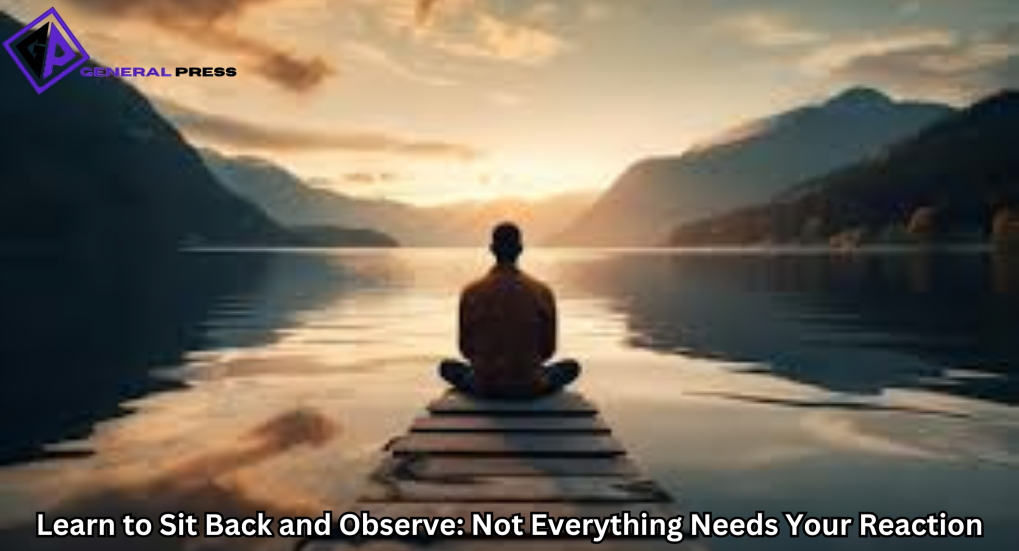In the fast-paced world we live in, the urge to respond, react, and engage with everything around us is stronger than ever. Social media notifications demand instant replies, heated debates call for immediate opinions, and life’s challenges often feel like battles that need to be fought head-on. But what if the real power lies in doing the opposite? What if sitting back and observing is the key to navigating life with wisdom and clarity? The phrase “Learn to sit back and observe. Not everything needs your reaction” — a sentiment echoed by Tymoff — holds a profound truth that can transform how we live.
The Art of Observation
To sit back and observe is to practice intentional mindfulness. Observation is not passive; it’s a deliberate act of pausing and paying attention without immediate judgment or interference. By observing, we allow ourselves to see situations as they are, rather than through the lens of our emotions or biases.
Think of a quiet lake. When the water is still, it reflects everything around it clearly. But if you stir the water, the reflection becomes distorted. Similarly, when we approach situations with haste or react impulsively, we often muddy the clarity of the moment. Observation, on the other hand, is like keeping the waters still, allowing us to understand the bigger picture before taking action.
Why Not Everything Needs Your Reaction
Also Read: Unlocking the Power of 770-404-4754: Your Ultimate Guide
The need to react is often tied to ego and emotion. When someone says something hurtful, we feel compelled to defend ourselves. When we see injustice, we feel the urge to speak out. While some reactions are necessary and justifiable, others only serve to escalate conflicts or drain our energy.
Not everything in life requires your immediate reaction. Some situations resolve themselves with time, while others don’t deserve the energy of a response. Silence and observation can be powerful tools, signaling strength and self-control.
For example, consider social media arguments. A heated comment thread can quickly spiral into negativity and hostility. By choosing to observe rather than engage, you save yourself from unnecessary stress and preserve your peace of mind. In doing so, you also set an example of restraint and maturity.
Benefits of Sitting Back and Observing
- Clarity of Thought
Observing gives you time to process what’s happening around you. Instead of reacting based on fleeting emotions, you can respond with clarity and thoughtfulness. This approach often leads to better decisions and fewer regrets. - Emotional Balance
Reacting immediately can amplify negative emotions like anger or frustration. By stepping back and observing, you allow yourself to detach emotionally, creating space for rational thinking. - Improved Relationships
In personal and professional relationships, impulsive reactions can lead to misunderstandings or conflict. Observation fosters empathy and understanding, as you’re more likely to listen and consider different perspectives before responding. - Stress Reduction
Constantly reacting to everything can be exhausting. Sitting back and observing helps you conserve your energy for what truly matters, reducing unnecessary stress. - Growth and Learning
Observation is a powerful tool for self-improvement. By watching how situations unfold, you gain insights into your own behavior and that of others. Over time, this leads to personal growth and a deeper understanding of the world.
How to Practice Sitting Back and Observing
- Pause Before Responding
When faced with a challenging situation, take a moment to pause. Count to ten, take a deep breath, or step away if needed. This brief pause can prevent you from reacting impulsively. - Practice Active Listening
Observation isn’t just about seeing; it’s also about listening. Pay attention to what others are saying without interrupting or planning your response. This not only helps you understand their perspective but also builds stronger connections. - Embrace Silence
Silence can be uncomfortable, but it’s also a powerful tool. Allowing silence in conversations or during conflicts gives everyone time to reflect and process their thoughts. - Cultivate Mindfulness
Mindfulness practices, such as meditation or journaling, can help you develop the habit of observing without reacting. These practices train your mind to focus on the present moment without judgment. - Focus on What You Can Control
Some situations are beyond your control. Instead of wasting energy reacting to things you can’t change, focus on what you can influence. Observation helps you distinguish between the two.
The Wisdom of Restraint
In a world that often glorifies action and immediacy, sitting back and observing might seem counterintuitive. However, restraint is a sign of wisdom and strength. It shows that you’re not a slave to your emotions or circumstances, but rather a master of your own mind.
Restraint doesn’t mean inaction or apathy; it means choosing your actions deliberately. It’s about knowing when to engage and when to step back. By practicing restraint, you create space for thoughtful responses and meaningful actions.
A Balanced Approach
Of course, there are times when action is necessary. Sitting back and observing doesn’t mean avoiding responsibility or ignoring problems. It’s about striking a balance. Act when your input is valuable and necessary. Observe when the situation can unfold on its own or when reacting would only add fuel to the fire.
FAQs:
1. What is the concept behind “Learn to Sit Back and Observe”?
This approach encourages individuals to pause and reflect before reacting to external stimuli, particularly in emotionally charged or stressful situations. It emphasizes mindfulness, self-awareness, and the power of choosing how to respond rather than reacting impulsively.
2. Why is it important not to react immediately to everything?
Immediate reactions, especially when influenced by emotions, can lead to regretful decisions, miscommunication, or unnecessary conflict. By learning to sit back and observe, you give yourself the space to think through your response carefully, fostering better emotional control and healthier interactions.
3. How can I start practicing “Sit Back and Observe”?
Begin by incorporating mindfulness practices into your daily routine. This could involve pausing for a few seconds before responding to a situation, taking deep breaths, or engaging in regular meditation to enhance your emotional regulation and awareness.
4. Does this approach mean I should ignore problems or avoid confrontation?
No, this method is not about avoiding challenges but about creating space to respond more thoughtfully. It allows you to address issues calmly and rationally, rather than reacting impulsively or out of frustration. It’s about choosing the most constructive course of action.
5. How does sitting back and observing benefit my mental health?
By reducing emotional reactivity, you allow yourself to cultivate a more balanced mindset, which can lower stress levels, prevent anxiety, and improve overall emotional resilience. It can lead to greater peace of mind and improved interpersonal relationships.
Final Thoughts
Learning to sit back and observe is a skill that takes time and practice, but the rewards are immense. It’s a mindset that fosters clarity, emotional balance, and personal growth. The next time you feel the urge to react, pause and remind yourself of Tymoff’s wisdom: “Not everything needs your reaction.” Sometimes, the most powerful thing you can do is simply watch, learn, and let go.




